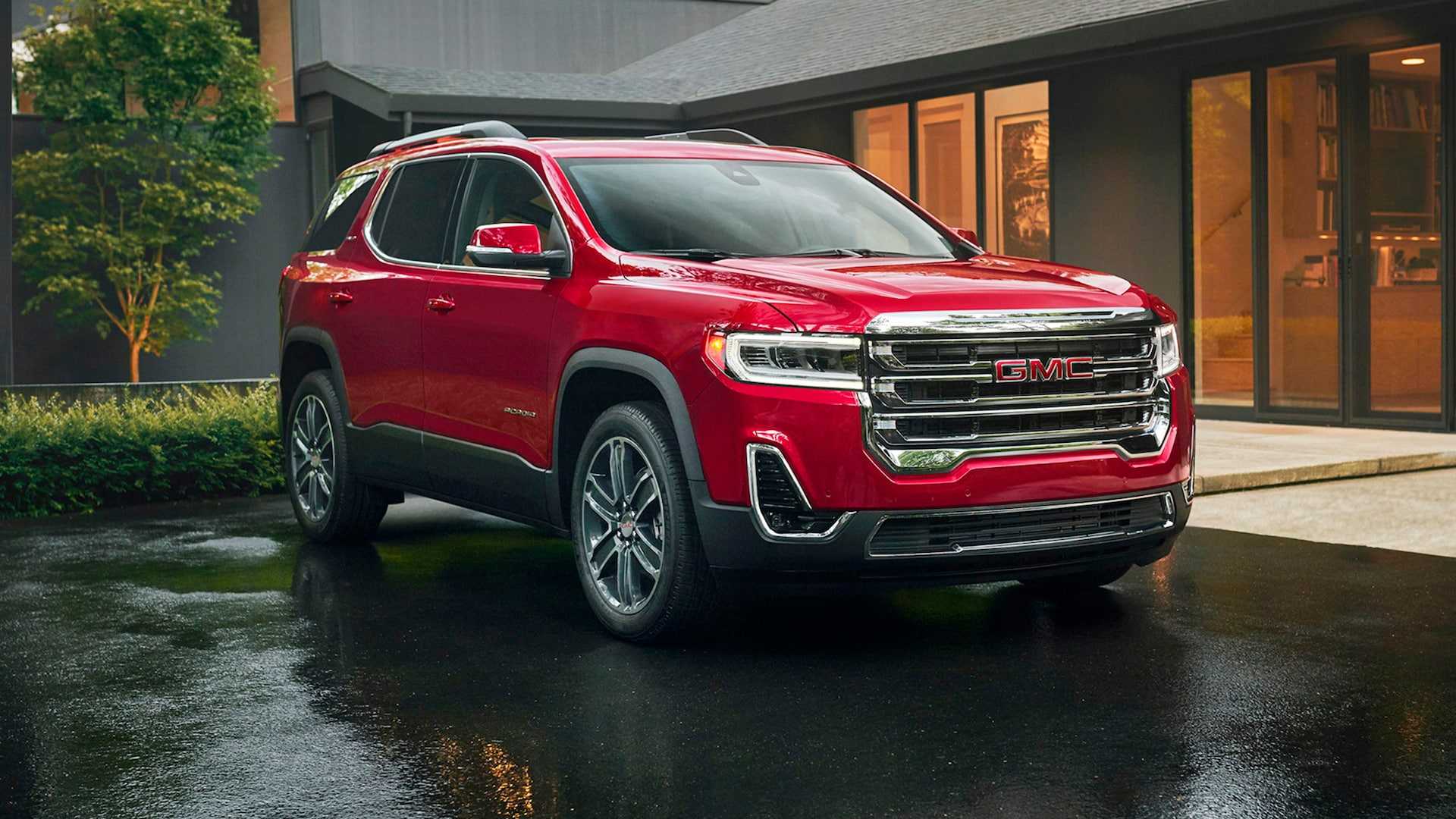GMC Acadia 2023 General Information and Vehicle Checks
It is important for owners of the 2023 GMC Acadia to know about their vehicle’s upkeep and how it works. The General Information and Vehicle Checks give owners this information. This includes information about the car’s specs, engine choices, suggested fuels, and regular repair schedules. It is important to do regular checks on the Acadia, such as checking the fluid levels, tyre pressure, and safety, to make sure it keeps running well and properly for as long as possible. Whether you’re a first-time user or an experienced driver, this detailed guide will teach you everything you need to know to keep your Acadia in good shape and drive safely.
2023 GMC ACADIA Specs, Price, Features and Mileage (Brochure)
General Information
For service and parts needs, visit your dealer. You will receive genuine GM parts and GM-trained and supported service people.
Genuine GM parts have one of these marks:

California Perchlorate Materials Requirements
Certain types of automotive applications, such as airbag initiators, seat belt pretensioners, and lithium batteries contained in electronic keys, may contain perchlorate materials. Perchlorate Material special handling may apply. See www.dtsc.ca.gov/hazardouswaste/ perchlorate.
Accessories and Modifications
Adding non-dealer accessories or making modifications to the vehicle can affect vehicle performance and safety, including such things as airbags, braking, stability, ride and handling, emissions systems, aerodynamics, durability, Driver Assistance Systems, and electronic systems like antilock brakes, traction control, and stability control. These accessories or modifications could even cause malfunction or damage not covered by the vehicle warranty. Damage to suspension components caused by modifying vehicle height outside of factory settings will not be covered by the vehicle warranty. Damage to vehicle components resulting from modifications or the installation or use of non-GM-certified parts, including control module or software modifications, is not covered under the terms of the vehicle warranty and may affect the remaining warranty coverage for affected parts. GM Accessories are designed to complement and function with other systems on the vehicle.
Vehicle Checks
Doing Your Own Service Work
It can be dangerous to work on your vehicle if you do not have the proper knowledge, service manual, tools, or parts. Always follow the owner’s manual procedures and consult the service manual for your vehicle before doing any service work. If doing some of your own service work, use the proper service manual. It tells you much more about how to service the vehicle than this manual can. This vehicle has an airbag system. If equipped with remote vehicle start, open the hood before performing any service work to prevent remote starting the vehicle accidentally. If doing some of your own service work, use the proper service manual. It tells you much more about how to service the vehicle than this manual can.
Caution
Even small amounts of contamination can cause damage to vehicle systems. Do not allow contaminants to contact the fluids, reservoir caps, or dipsticks.
Doing Your Own Service Work
Warning
It can be dangerous to work on your vehicle if you do not have the proper knowledge, service manual, tools, or parts. Always follow the owner’s manual procedures and consult the service manual for your vehicle before doing any service work. If doing some of your own service work, use the proper service manual. It tells you much more about how to service the vehicle than this manual can. This vehicle has an airbag system. If equipped with remote vehicle start, open the hood before performing any service work to prevent remote starting the vehicle accidentally. Keep a record with all parts receipts and list the mileage and the date of any service work performed.
Caution
Even small amounts of contamination can cause damage to vehicle systems. Do not allow contaminants to contact the fluids, reservoir caps, or dipsticks.
Hood
Warning
For vehicles with auto engine stop/start, turn the vehicle off before opening the hood. If the vehicle is on, the engine will start when the hood is opened. You or others could be injured. Components under the hood can get hot from running the engine. To help avoid the risk of burning unprotected skin, never touch these components until they have cooled, and always use a glove or towel to avoid direct skin contact. Clear any snow from the hood before opening.
To open the hood:
- Pull the hood release lever with the i symbol. It is on the lower left side of the instrument panel.
- Go to the front of the vehicle and locate the secondary release lever under the front center of the hood. Push the secondary hood release lever to the right to release.
- After you have partially lifted the hood, the gas strut system will automatically lift the hood and hold it in the fully open position.
To close the hood:
- Before closing the hood, be sure all filler caps are on properly, and all tools are removed.
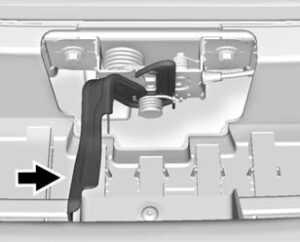
- Pull the hood down until the strut system is no longer holding up the hood.
- Allow the hood to fall. Check to make sure the hood is latched completely. Repeat this process with additional force if necessary.
Warning
Do not drive the vehicle if the hood is not latched completely. The hood could open fully, block your vision, and cause a crash. You or others could be injured. Always close the hood completely before driving.
Engine Compartment Overview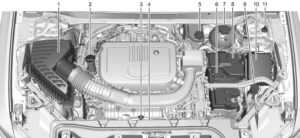
2.0L L4 Turbo Engine
- Engine Air Cleaner/Filter 0 271.
- Engine Oil Fill Cap.
- Engine Oil Dipstick.
- Engine Cooling Fan (Out of View).
- Brake Fluid Reservoir.
- Battery – North America 0 279.
- Engine Coolant Surge Tank and Pressure Cap.
- Positive (+) Battery Terminal (Under Cover).
- Windshield Washer Fluid Reservoir.
- Engine Compartment Fuse Block
- Remote Negative (-) Battery Terminal.

3.6L V6 Engine
- Engine Air Cleaner/Filter 0 271.
- Engine Oil Fill Cap.
- Engine Oil Dipstick.
- Engine Cooling Fan (Out of View).
- Windshield Washer Fluid Reservoir.
- Brake Fluid Reservoir.
- Battery – North America
- Engine Coolant Surge Tank and Pressure Cap.
- Positive (+) Battery Terminal.
- Engine Compartment Fuse Block
- Remote Negative (-) Battery Terminal.
Engine Oil
To ensure proper engine performance and long life, careful attention must be paid to engine oil.
Following these simple, but important steps will help protect your investment:
- Use engine oil approved to the proper specification and of the proper viscosity grade. See “Selecting the Right Engine Oil” in this section.
- Check the engine oil level regularly and maintain the proper oil level. See “Checking Engine Oil” and “When to Add Engine Oil” in this section.
- Change the engine oil at the appropriate time.
- Always dispose of engine oil properly.
Checking Engine Oil
Check the engine oil level regularly, every 650 km (400 mi), especially prior to a long trip. The engine oil dipstick handle is a loop.
Warning
The engine oil dipstick handle may be hot; it could burn you. Use a towel or glove to touch the dipstick handle. If a low oil Driver Information Center (DIC) message displays, check the oil level.
Follow these guidelines:
- To get an accurate reading, park the vehicle on level ground. Check the engine oil level after the engine has been off for at least two hours. Checking the engine
oil level on steep grades or too soon after engine shutoff can result in incorrect readings. Accuracy improves when checking a cold engine prior to starting. - Remove the dipstick and check the level.
- If unable to wait two hours, the engine must be off for at least 15 minutes if the engine is warm, or at least 30 minutes if the engine is not warm. Pull out the dipstick, wipe it with a clean paper towel or cloth, then push it back in all the way.
- Remove it again, keeping the tip down, and check the level.
When to Add Engine Oil
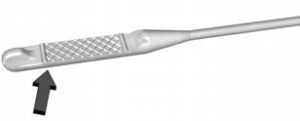
2.0L L4 Turbo Engine

3.6L V6 Engine
If the oil is below the cross-hatched area at the tip of the dipstick and the engine has been off for at least 15 minutes, add 1 L (1 qt) of the recommended oil and then recheck the level. See “Selecting the Right Engine Oil” later in this section for an explanation of what kind of oil to use. For engine oil crankcase capacity,
Caution
Do not add too much oil. Oil levels above or below the acceptable operating range shown on the dipstick are harmful to the engine. If the oil level is above the operating range (i.e., the engine has so much oil that the oil level gets above the cross-hatched area that shows the proper operating range), the engine could be damaged. Drain the excess oil or limit driving of the vehicle, and seek a service professional to remove the excess oil. Add enough oil to put the level somewhere in the proper operating range. Push the dipstick all the way back in when through.
Selecting the Right Engine Oil
Selecting the right engine oil depends on both the proper oil specification and viscosity grade.
Specification
Use full synthetic engine oils that meet the dexos1 specification. Engine oils that have been approved by GM as meeting the dexos1 specification are marked with the dexos1-approved logo. See www.gmdexos.com.
Caution
Failure to use the recommended engine oil or equivalent can result in engine damage not covered by the vehicle warranty.
Viscosity Grade
For the 2.0L L4 Turbo engine, use SAE 0W-20 viscosity grade engine oil. For the 3.6L V6 engine, use SAE 5W-30 viscosity grade engine oil.
Cold Temperature Operation: In an area of extreme cold, where the temperature falls below −29 °C (−20 °F), an SAE 0W-30 oil may be used. An oil of this viscosity grade will provide easier cold starting for the engine at extremely low temperatures. When selecting an oil of the appropriate viscosity grade, it is recommended to select an oil of the correct specification. See “Specification” earlier in this section.
Engine Oil Additives/Engine Oil Flushes
Do not add anything to the oil. The recommended oils meeting the dexos1 specification are all that is needed for good performance and engine protection. Engine oil system flushes are not recommended and could cause engine damage not covered by the vehicle warranty.
What to Do with Used Oil
Used engine oil contains certain elements that can be unhealthy for your skin and could even cause cancer. Do not let used oil stay on your skin for very long. Clean your skin and nails with soap and water, or a good hand cleaner. Wash or properly dispose of clothing or rags containing used engine oil. See the manufacturer’s warnings about the use and disposal of oil products. Used oil can be a threat to the environment. If you change your own oil, be sure to drain all the oil from the filter before disposal. Never dispose of oil by putting it in the trash or pouring it on the ground, into sewers, or into streams or bodies of water. Recycle it by taking it to a place that collects used oil.
Engine Oil Life System
When to Change Engine Oil
This vehicle has a computer system that indicates when to change the engine oil and filter. This is based on a combination of factors which include engine revolutions, engine temperature, and miles driven. Based on driving conditions, the mileage at which an oil change is indicated can vary considerably. For the oil life system to work properly, the system must be reset every time the oil is changed. When the system has calculated that oil life has been diminished, it indicates that an oil change is necessary. A CHANGE ENGINE OIL SOON message comes on. Change the oil as soon as possible within the next 1 000 km (600 mi). It is possible that, if driving under the best conditions, the oil life system might indicate that an oil change is not necessary for up to a year. The engine oil and filter must be changed at least once a year and, at this time, the system must be reset. Your dealer has trained service people who will perform this work and reset the system. It is also important to check the oil regularly over the course of an oil drain interval and keep it at the proper level. If the system is ever reset accidentally, the oil must be changed at 5 000 km (3,000 mi) since the last oil change. Remember to reset the oil life system whenever the oil is changed.
How to Reset the Engine Oil Life System
Reset the system whenever the engine oil is changed so that the system can calculate the next engine oil change.
To reset the system:
- Press and hold V on the DIC while the Oil Life display is active. The oil life will change to 100%.
If the CHANGE ENGINE OIL SOON message comes back on when the vehicle is started, the engine oil life system has not been reset. Repeat the procedure.
Automatic Transmission Fluid
It is not necessary to check the transmission fluid level. A transmission fluid leak is the only reason for fluid loss. If a leak occurs, take the vehicle to the dealer and have it repaired as soon as possible.
Caution
Use of the incorrect automatic transmission fluid may damage the vehicle, and the damage may not be covered by the vehicle warranty. Always use the correct automatic transmission fluid. If you need to check the transmission fluid level, take the vehicle to your dealer.
Engine Air Filter Life System
If equipped, this feature provides the engine air filter’s remaining life and best timing for a change. The timing to change an engine air filter depends on driving and environmental conditions.
When to Change Engine Air Filter
When the Driver Information Center (DIC) displays a message to replace the engine air filter at the next oil change, follow this timing. When the DIC displays a message to replace the engine air filter soon, replace the engine air filter at your earliest convenience. The system must be reset after the engine air filter is changed. If the DIC displays a message to check the engine air filter system, see your dealer.
How to Reset Engine Air Filter Life System
To reset:
- Place the vehicle in P (Park).
- Display the Air Filter Life on the DIC.
- Press p to move to the Reset/Disable display area. Select Reset then press V.
- Press V to confirm to
Engine Air Cleaner/Filter
The engine air cleaner/filter is in the engine compartment on the passenger side of the vehicle.
When to Inspect the Engine Air Cleaner/ Filter
If the vehicle is not equipped with the engine air filter life system If equipped with the engine air filter life system,
How to Inspect/Replace the Engine Air Cleaner/Filter
Do not start the engine or have the engine running with the engine air cleaner/filter housing open. Before removing the engine air cleaner/filter, make sure that the engine air cleaner/filter housing and nearby components are free of dirt and debris. Do not clean the engine air cleaner/filter or components with water or compressed air.
To inspect or replace the air cleaner/filter:

2.0L L4 Turbo Engine
- Remove the five screws and lift the cover out of the assembly
Warning
If part replacement is necessary, the part must be replaced with one of the same part number or with an equivalent part. Use of a replacement part without the same fit, form, and function may result in personal injury or damage to the vehicle. - Inspect or replace the engine air cleaner/ filter.
- Lower the cover and secure with the five screws.
- If equipped, reset the engine air filter life system after replacing the engine air filter.
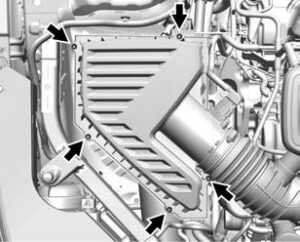
Warning
Operating the engine with the air cleaner/filter off can cause you or others to be burned. Use caution when working on the engine. Do not start the engine or drive the vehicle with the air cleaner/ filter off, as flames may be present if the engine backfires.
Caution
If the air cleaner/filter is off, dirt can easily get into the engine, which could damage it. Always have the air cleaner/ filter in place when driving.
Cooling System
The cooling system allows the engine to maintain the correct working temperature
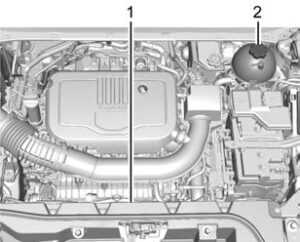
2.0L L4 Engine
- Engine Cooling Fan (Out of View)
- Engine Coolant Surge Tank and
- Pressure Cap

3.6L V6 Engine
- Engine Cooling Fan (Out of View)
- Engine Coolant Surge Tank and Pressure Cap
Warning
An under-hood electric fan can start up even when the engine is not running and can cause injury. Keep hands, clothing, and tools away from any underhood electric fan.
Warning
Do not touch the heater or radiator hoses or other engine parts. They can be very hot and can burn you. Do not run the engine if there is a leak; all coolant could leak out. That could cause an engine fire and can burn you. Fix any leak before driving the vehicle.
Engine Coolant
The cooling system in the vehicle is filled with DEX-COOL engine coolant. This coolant needs to be checked and replaced at appropriate intervals. The following explains the cooling system and how to check and add coolant when it is low.
What to Use
Warning
Do not touch the heater or radiator hoses or other engine parts. They can be very hot and can burn you. Do not run the engine if there is a leak; all coolant could leak out. That could cause an engine fire and can burn you. Fix any leak before driving the vehicle.
Use a 50/50 mixture of clean, drinkable water and DEX-COOL coolant. This mixture:
- Gives freezing protection down to −37 °C (−34 °F), the outside temperature.
- Gives boiling protection up to 129 °C (265 °F), engine temperature.
- Protects against rust and corrosion.
- Will not damage aluminum parts.
- Helps keep the proper engine temperature.
Caution
Do not use anything other than a mix of DEX-COOL coolant that meets GM Standard GMW3420 and clean, drinkable water. Anything else can cause damage to the engine cooling system and the vehicle, which would not be covered by the vehicle warranty. Never dispose of engine coolant by putting it in the trash, pouring it on the ground, or into sewers, streams, or bodies of water. Have the coolant been changed by an authorized service center, familiar with legal requirements regarding used coolant disposal? This will help protect the environment and your health.
Checking Coolant
The vehicle must be on a level surface when checking the coolant level.
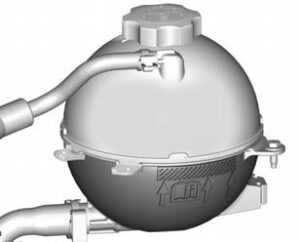
Check to see if coolant is visible in the coolant surge tank. If the coolant inside the coolant surge tank is boiling, do not do anything else until it cools down. The coolant surge tank is located in the engine compartment on the driver’s side of the vehicle.
Warning
Spilling coolant on hot engine parts can burn you. Coolant contains ethylene glycol and it will burn if the engine parts are hot enough.
Warning
Steam and scalding liquids from a hot cooling system are under pressure. Turning the pressure cap, even a little, can cause them to come out at high speed and you could be burned. Never turn the cap when the cooling system, including the pressure cap, is hot. Wait for the cooling system and pressure cap to cool.
Warning
Plain water, or other liquids such as alcohol, can boil before the proper coolant mixture will. With plain water or the wrong mixture, the engine could get too hot but there would not be an overheat warning. The engine could catch fire and you or others could be burned.
Caution
Failure to follow the specific coolant fill procedure could cause the engine to overheat and could cause system damage. If coolant is not visible in the surge tank, contact your dealer. If no problem is found, check to see if coolant is visible in the coolant surge tank. If coolant is visible but the coolant level is not at or above the indicated mark, add a 50/50 mixture of clean, drinkable water and DEX-COOL coolant. Be sure the cooling system, including the coolant surge tank pressure cap, is cool before you do it.
How to Add Coolant to the Coolant Surge Tank (3.6L V6 Engine Only)

- Remove the coolant surge tank pressure cap when the cooling system, including the coolant surge tank pressure cap and upper radiator hose, is no longer hot.
- Turn the pressure cap slowly counterclockwise about one-quarter of a turn. If you hear a hiss, wait for that to stop. This will allow any pressure still left to be vented out the discharge hose.
- Keep turning the pressure cap slowly and remove it.
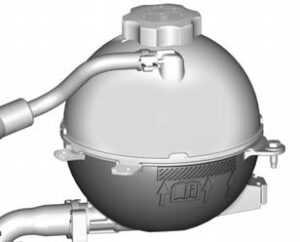
- Fill the coolant surge tank with the proper mixture to the indicated level mark.
- With the coolant surge tank pressure cap off, start the engine and let it run until you can feel the upper radiator hose getting hot. Watch out for the engine cooling fan.
By this time, the coolant level inside the coolant surge tank may be lower. If the level is lower, add more of the proper mixture to the coolant surge tank until the level reaches the indicated level mark. - Replace the pressure cap tightly.
- Verify coolant level after the engine is shut off and the coolant is cold.
If necessary, repeat coolant fill procedure Steps 1–6.
If the coolant still is not at the proper level when the system cools down again, see your dealer.
Caution
If the pressure cap is not tightly installed, coolant loss and engine damage may occur. Be sure the cap is properly and tightly secured.
Automatic Coolant Service Fill (2.0L L4 Engine Only)
If equipped, this feature assists in filling and removing air from the cooling system after service of components or when coolant is added after being too low.
To activate the fill and air removal process:
- With a cold system, disconnect the vent line from the port near the cap on the surge tank. Add coolant to the indicated mark on the surge tank.
- Reconnect the vent line to the surge tank and replace the cap on the surge tank.
- Connect the vehicle to a battery
- Put the vehicle in Service See
Ignition Positions 0 204.
- Turn off the air
- Set the parking
- At the same time, press the accelerator and the brake for automatic transmission vehicles for two seconds, then release.
At the end of the cycle, check the coolant level in the surge tank and add coolant, if it is low. Turn off the vehicle, allow the Engine Control Module (ECM) to go to sleep, for about two minutes, and repeat steps 3-7. Listen for pump activation and movement of the control valves while watching the level of the tank. If the tank empties, turn the ignition off, carefully remove the surge tank cap, refill to the indicated mark, and repeat steps 3-6. The fill and air removal process will run for approximately 10 minutes.
Engine Overheating
The vehicle has several indicators to warn of the engine overheating. There is an engine coolant temperature gauge on the instrument cluster. The vehicle may also display a message on the Driver Information Center (DIC). If the decision is made not to lift the hood when this warning appears, get service help right away. If the decision is made to lift the hood, make sure the vehicle is parked on a level surface. Then check to see if the engine cooling fan is running. If the engine is overheating, the fan should be running. If it is not, do not continue to run the engine. Have the vehicle serviced?
Caution
Do not run the engine if there is a leak in the engine cooling system. This can cause a loss of all coolant and can damage the system and vehicle. Have any leaks fixed right away?
If Steam Is Coming from the Engine Compartment
Steam and scalding liquids from a hot cooling system are under pressure. Turning the pressure cap, even a little, can cause them to come out at high speed and you could be burned. Never turn the cap when the cooling system, including the pressure cap, is hot. Wait for the cooling system and pressure cap to cool.
If No Steam Is Coming from the Engine Compartment
If an engine overheat warning is displayed but no steam can be seen or heard, the problem may not be too serious. Sometimes the engine can get a little too hot when the vehicle:
- Climbs a long hill on a hot
- Stops after high-speed
- Idles for long periods in
If the overheat warning is displayed with no sign of steam:
- Turn the air conditioning
- Turn the heater on to the highest temperature and to the highest fan Open the windows as necessary.
- When it is safe to do so, pull off the road, shift to P (Park) or N (Neutral), and let the engine idle.
If the engine coolant temperature gauge is no longer in the overheated area, the vehicle can be driven. Continue to drive the vehicle slowly for about 10 minutes. Keep a safe distance from the vehicle in front. If the warning does not come back on, continue to drive normally and have the cooling system checked for proper fill and function. If the warning continues, pull over, stop, and park the vehicle right away. If there is no sign of steam, idle the engine for three minutes while parked. If the warning is still displayed, turn off the engine until it cools down.
Washer Fluid
What to Use
When windshield washer fluid is needed, be sure to read the manufacturer’s instructions before use. If operating the vehicle in an area where the temperature may fall below freezing, use a fluid that has sufficient protection against freezing.
Adding Washer Fluid

Open the cap with the washer symbol on it. Add washer fluid until the tank is full.
Caution
- Do not use a washer fluid that contains any type of water-repellent coating.
- This can cause the wiper blades to chatter or skip.
- Do not use engine coolant (antifreeze) in the windshield washer. It can damage the windshield washer system and paint.
- Do not mix water with ready-to-use washer fluid. Water can cause the solution to freeze and damage the washer fluid tank and other parts of the washer system.
- When using concentrated washer fluid, follow the manufacturer’s instructions for adding water.
- Fill the washer fluid tank only three-quarters full when it is very cold.
- This allows for fluid expansion if freezing occurs, which could damage the tank if it is completely full.
Brakes
Disc brake linings have built-in wear indicators that make a high-pitched warning sound when the brake linings are worn and new linings are needed. The sound can come and go or can be heard all the time when the vehicle is moving, except when applying the brake pedal firmly.
Warning
The brake wear warning sound means that soon the brakes will not work well. That could lead to a crash. When the rake-wear warning sound is heard, have the vehicle serviced.
Caution
Continuing to drive with worn-out brake linings could result in costly brake repairs Some driving conditions or climates can cause a brake squeal when the brakes are first applied, clearing up following several applications. This does not mean something is wrong with the brakes. Properly torqued wheel nuts are necessary to help prevent brake pulsation. When tires are rotated, inspect brake linings for wear and evenly tighten wheel nuts in the proper sequence to torque specifications. Brake pads should be replaced as complete axle sets.
Brake Pedal Travel
See your dealer if the brake pedal does not return to normal height, or if there is a rapid increase in pedal travel. This could be a sign that brake service may be required.
Replacing Brake System Parts
Always replace brake system parts with new, approved replacement parts. If this is not done, the brakes may not work properly. The braking performance can change in many ways if the wrong brake parts are installed or if parts are improperly installed.
Brake Fluid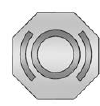
The brake master cylinder reservoir is filled with GM-approved DOT 4 brake fluid as indicated on the reservoir cap.
Checking Brake Fluid
With the vehicle in P (Park) on a level surface, the brake fluid level should be between the minimum and maximum marks on the brake fluid reservoir.
There are only two reasons why the brake fluid level in the reservoir may go down:
- Normal brake lining wear. When new linings are installed, the fluid level goes back up.
- A fluid leak in the brake hydraulic system. Has the brake hydraulic system been fixed?
With a leak, the brakes will not work well. Always clean the brake fluid reservoir cap and the area around the cap before removing it. Do not top off the brake fluid. Adding fluid does not correct a leak. If the fluid is added when the linings are worn, there will be too much fluid when new brake linings are installed. Add or remove fluid, as necessary, only when work is done on the brake hydraulic system.
Warning
If too much brake fluid is added, it can spill on the engine and burn, if the engine is hot enough. You or others could be burned, and the vehicle could be damaged. Add brake fluid only when work is done on the brake hydraulic system.
When the brake fluid falls to a low level, the brake warning light comes on. Brake fluid absorbs water over time which degrades the effectiveness of the brake fluid. Replace brake fluid at the specified intervals to prevent increased stopping distance.
What to Add
Use only GM-approved DOT 4 brake fluid from a clean, sealed container.
Warning
The wrong or contaminated brake fluid could result in damage to the brake system. This could result in the loss of braking leading to a possible injury. Always use the proper GM-approved brake fluid.
Caution
If brake fluid is spilled on the vehicle’s painted surfaces, the paint finish can be damaged. Immediately wash off any painted surface.
Battery – North America
The original equipment battery is maintenance-free. Do not remove the cap and do not add fluid. Refer to the replacement number shown on the original battery label when a new battery is needed. See Engine Compartment Overview 0 265 for battery location. For replacement of the battery, see your dealer. The vehicle has an Absorbed Glass Mat (AGM) 12-volt battery. Installation of a standard 12-volt battery will result in reduced 12-volt battery life. Some 12-volt battery chargers have an AGM battery setting on the charger. If available, use the AGM setting on the charger to limit charge voltage to 14.8 volts. Follow the charger manufacturer’s instructions.
Stop/Start System: The vehicle has a Stop/Start system to shut off the engine to help conserve fuel.
Vehicle Storage: Batteries have acid that can burn you and gas that can explode. You can be badly hurt if you are not careful. Always wear eye protection for tips on working around a battery without getting hurt.
Infrequent Usage: Remove the black, negative (−) cable from the battery to keep the battery from running down.
Extended Storage: Remove the black, negative (−) cable from the battery or use a battery trickle charger.
All-Wheel Drive
Transfer Case
Under normal driving conditions, transfer case fluid does not require maintenance unless there is a fluid leak or unusual noise. If required, have the transfer case serviced by your dealer.
Park Brake and P (Park) Mechanism Check
When you are doing this check, the vehicle could begin to move. You or others could be injured and property could be damaged. Make sure there is room in front of the vehicle in case it begins to roll. Be ready to apply the regular brake at once should the vehicle begin to move. Park on a fairly steep hill, with the vehicle facing downhill. Keeping your foot on the regular brake, set the parking brake.
- To check the parking brake’s holding ability: With the engine running and the transmission in N (Neutral), slowly remove foot pressure from the regular brake pedal. Do this until the vehicle is held by the parking brake only.
- To check the P (Park) mechanism’s holding ability: With the engine running, shift to P (Park). Then release the parking brake followed by the regular brake. Contact your dealer if service is required
Wiper Blade Replacement
Windshield wiper blades should be inspected for wear or cracking. It is a good idea to clean or replace the wiper blade assembly on a regular basis or when worn.
Caution
Allowing the wiper arm to touch the windshield when no wiper blade is installed could damage the windshield. Any damage that occurs would not be covered by the vehicle warranty. Do not allow the wiper arm to touch the windshield.
Front Wiper Blade Replacement
To replace the wiper blade assembly:
- Pull the windshield wiper assembly away from the windshield.
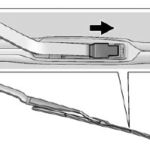
- Lift up on the latch in the middle of the wiper blade where the wiper arm attaches.
- With the latch open, pull the wiper blade down toward the windshield far enough to release it from the J-hooked end of the wiper arm.
- Remove the wiper blade.
- Reverse Steps 1–3 for wiper blade replacement.
Rear Wiper Blade Replacement
To remove the wiper blade:
- Lift the wiper arm away from the window. The rear wiper arm will only lift off the glass at a small angle to allow for wiper blade removal. The rear wiper arm will not lock in a service-up position so care should be taken when replacing the rear wiper blade.

- Push the release lever to disengage the hook and push the wiper arm toward the center of the vehicle and out of the blade assembly.
- Push the new blade assembly securely on the wiper arm until the release lever clicks into place.
Windshield Replacement
Driver Assistance Systems
If the windshield needs to be replaced and the vehicle is equipped with a front camera sensor for the Driver Assistance Systems, a GM replacement windshield is recommended. The replacement windshield must be installed according to GM specifications for proper alignment. If it is not, these systems may not work properly, they may display messages, or they may not work at all. See your dealer for proper windshield replacement.
Gas Strut(s)
Your vehicle may be equipped with gas strut(s) to provide assistance in lifting and holding open the hood/trunk/liftgate system in full open position.
Warning
If the gas struts that hold open the hood, trunk, and/or liftgate fail, you or others could be seriously injured. Take the vehicle to your dealer for service immediately. Visually inspect the gas struts for signs of wear, cracks, or other damage periodically. Check to make sure the hood/trunk/liftgate is held open with enough force. If struts are failing to hold the hood/trunk/liftgate, do not operate. Have the vehicle serviced.
Caution
Do not apply tape or hang any objects from gas struts. Also, do not push down or pull on gas struts. This may cause damage to the vehicle.
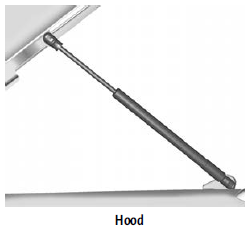

FAQ
Detailed specifications for the Acadia can typically be found in the owner’s manual or the manufacturer’s website.
The Acadia may offer various engine options, including gasoline and hybrid powertrains, depending on the model and trim level.
The Acadia usually requires regular unleaded gasoline, but it’s important to check the specific fuel recommendations for your model.
Yes, the owner’s manual typically includes a maintenance schedule outlining recommended service intervals.
Tire pressure should be checked regularly, typically monthly, and before long trips. Refer to the owner’s manual for specific recommendations.
Yes, the owner’s manual usually includes guidelines for tire rotation and alignment.
You should regularly check engine oil, coolant, transmission fluid, brake fluid, and windshield washer fluid levels.
Brake inspections are typically recommended at regular service intervals and whenever you notice signs of brake wear or issues.
Safety inspections should include checks of the brakes, lights, signals, tires, and overall vehicle condition. It’s essential to ensure all safety systems are functioning correctly.
You can check for recalls and service bulletins by visiting the manufacturer’s website or contacting your dealership.
Yes, the owner’s manual typically provides recommendations for air filter replacement intervals.
Yes, the owner’s manual typically provides recommendations for air filter replacement intervals.
Instructions for jump-starting the vehicle can often be found in the owner’s manual.
If you notice any unusual sounds or issues during a vehicle check, it’s advisable to consult the owner’s manual and, if necessary, contact a qualified technician.
Routine vehicle checks typically require basic tools such as a tire pressure gauge and a flashlight. Specialized tools are generally not needed for basic maintenance.
Useful Link
View Full User Guide: GMC Acadia 2023 User Guide
Download Manuals: https://www.cadillac.com/support/vehicle/manuals-guides
2023 GMC ACADIA Specs, Price, Features and Mileage (Brochure)

